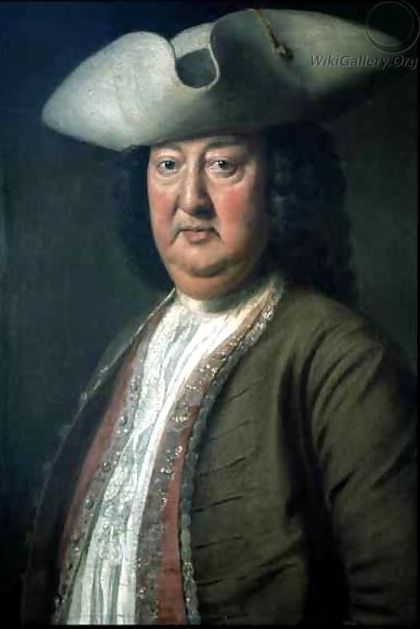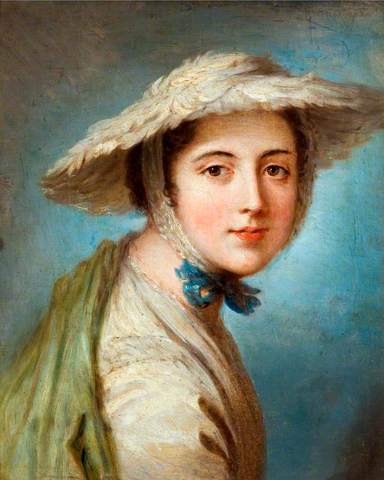HOARE, William
William Hoare was born at Thorndon, near Eye, Suffolk in 1707, eldest of the three surviving children of William Hoare, a prosperous farmer and land agent, and his wife Anne, they had an earlier son William Hoare, who died shortly after his birth in 1703. The family moved to Berkshire and William was sent to school at Great Faringdon, Berkshire where he showed an early talent for drawing and in the early 1720s his father was persuaded to send him to London to join the studio of Giuseppe Grisoni (1699-1769), an Italian who had come to England in 1718. When Grisoni returned to Rome in 1728, he took Hoare with him and where Hoare shared lodgings with artist Peter Angelis (1785-1734) and sculptors Laurent Delvaux (1696-1778) and Peter Scheemakers (1691-1781), at 53 Via Gregoriana. He then joined the studio of Francesco Fernandi, called Imperiali (1679-1740), a history painter, and frequented the studios of the French Academy nearby in the Corso. Personable and well educated, William formed lasting friendships with many young grand tourists who became his patrons: Henry Bathurst, the future second (1714-1794) and third (1762-1834), dukes of Beaufort, Robert Dingley (c.1710-1781), Henry Hoare (1705–1785) (no relation), George Lyttelton (1709-1773), Charles Hanbury Williams (1798-1759), and Joseph Spence (1699-1768), tutor to the future second Duke of Dorset and later to the Earl of Lincoln. Hoare returned to England around 1738 and had connections with the entourage of Frederick, Prince of Wales, and drew the prince's portrait in pastel but failing to prosper in London, decided to move to Bath, Somerset, where the Bath seasons were to furnish him with a constant stream of sitters. Hoare came to the notice of Beau Nash (1674-1761) and Ralph Allen (1693-1764), whose portraits he painted in oil. In 1742 Hoare was elected a visitor to the Mineral Water Hospital, the duty of which he performed regularly until 1779, and this appointment brought him many commissions including a major commission for an altarpiece for the Octagon Chapel in Bath, 'The Pool of Bethesda'. A habitué of Stourhead, he furnished the younger Henry Hoare with many family portraits which are still in situ. On 4 October 1742, Hoare married at Lincoln's Inn Chapel, London, Elizabeth Barker, and they had five children: Mary (1744–1820), who was an artist in crayon, Anne (1751–1821), William jun. (1752–1809), the playwright and painter Prince Hoare (1755–1834), and Georgiana (b. 1759), who died in infancy. Many of Hoare's old Rome acquaintances had become his patrons, and a substantial part of his income came from politicians' portraits including William Pitt the Elder. Hoare remained in close touch with the London art milieu and was connected to the Foundling Hospital and to the Magdalen Hospital, to which he presented a portrait of Robert Dingley, its founder, in 1762. In 1755, Hoare joined others in signing a request for the founding of an academy and on 11 December 1769, became a founder member of the Royal Academy at the king's special request, exhibiting intermittently. Hoare died in Edgar Buildings, Bath, on 10 December 1792, and his wife on 30 November 1793. There is a wall tablet to both in Walcot church, near Bath, and a wall monument to Hoare by Chantrey (1828) in Bath Abbey.
Royal Academy Exhibits
At Bath
1770 104 The Portrait of Two Children, in pastels
105 A Portrait of a Young Midshipman, whole length
106 A View of the Gardens of Henry Hoare, Esq., in Stourhead, Wilts.
1771 94 A Portrait of a Lady and a Boy, whole length
1772 114 Portrait of a Boy, full length
115 Portrait of a Boy in the character of Cupid - crayon
116 Prudence instructing her pupil - crayon
117 A Diana - crayon
1773 137 A Gentleman, and Lady, and Child, half length
138 A Lady, ditto, ditto
139 ditto, ditto
140 ditto, ditto
141 A Gentleman, three quarters
1774 122 Portrait of a Gentleman, half length
123 ditto of a Lady in the character of Emma, half length
124 A Zingara - crayon
1776 130 Portrait of a Lady, whole length
131 ditto of three young Gentlemen
1779 130 A Gentleman and his daughter, half length
131 A Young Student, whole length
132 A Landscape with the Sun going down
133 A Child laying on a Sofa - crayons
Works by This Artist

|
Portrait of Richard Beau Nash 1674-1761Oil on Canvas |

|
Head of a Girl Wearing a White HatOil on canvas
|